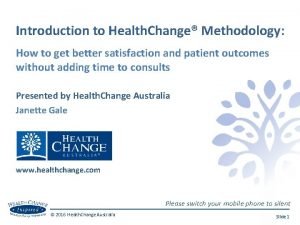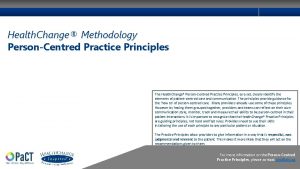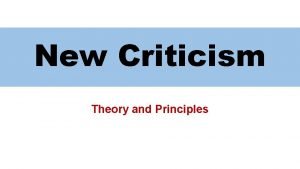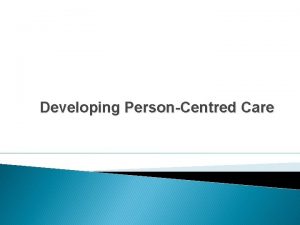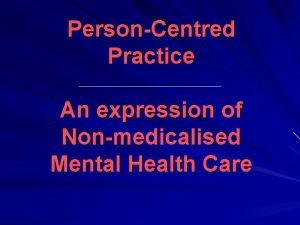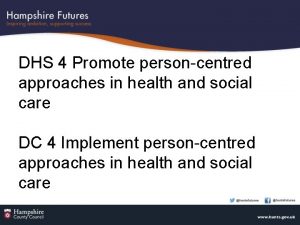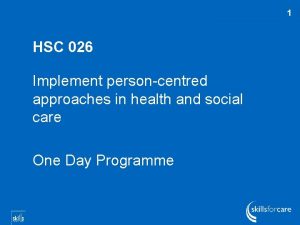Health Change Methodology PersonCentred Practice Principles The Health












- Slides: 12

Health. Change® Methodology Person-Centred Practice Principles The Health. Change® Person-Centred Practice Principles, as a set, clearly identify the elements of patient-centred care and communication. The principles provide guidance for the ‘how to’ of person-centred care. Many providers already use some of these principles. However by having them grouped together, providers and teams can reflect on their own communication style, monitor, track and measure their ability to be person-centred in their patient interactions. It is important to recognize that the Health. Change® Practice Principles are guiding principles, not hard and fast rules. Providers need to use their skills in tailoring the use of each principle to any particular patient or situation. The Practice Principles allow providers to give information in a way that is respectful, nonjudgmental and relevant to the patient. This makes it more likely that they will act on the recommendations given to them. For more information on the Person-Centred Practice Principles, please contact phc@ahs. ca

What are they? Client Centred Client Choice Client Control Call it as you see it (with tact) Four aspects of goal setting One thing at a time One step at a time Adding up over time The RICk Principle™ First ask, then offer WAIT til 8 Invite the client to write Trial & Error Click on a topic area to find out more information.

Client Centred, Client Choice, Client Control (The 3 C’s) What it is Example Be person-centred by balancing your duty of care with patients' rights to make fully informed, conscious decisions about what actions they will take Offer patients choice whenever possible and focus on what matters to them. “You have prioritized sleep management as the area you would benefit most from. Before you move forward with that, there are some important things I’d like you to know about your medication can we discuss that now? " Back to full list

Call it as you See it (with Tact) Use honest and open communication with patients and tactfully discuss apparent low readiness to act on recommendations After observing body language that suggests the patient isn't engaged, ask "Mr. Jones how are you feeling about our conversation so far? Is this still your priority area or is there something else you would like to discuss with me about your health? " What it is Example Back to full list

Four Aspects of Goal Setting What it is Example Four aspects to completing effective patient-centred goals: 1. Objective clinical targets; 2. Behavioural action categories; 3. Short-term behavioural personalized health goals; and 4. Motivational drivers. I want to be able to get travel insurance so I can 'snowbird' in Phoenix with my friends. I will need to work towards getting a blood pressure of 120/80. I will start by focusing on monitoring and managing my symptoms. I will write down in my notebook any symptoms I get throughout the day and I will take my blood pressure reading each day before breakfast. Back to full list

One Thing at a Time, One Step at a Time, Adding up over Time Do goal setting and action planning in a person-centred way to ensure goals and actions are realistic, manageable and clinically effective over time “There a number of things that you will need to work on to reach your health goal(s) but it wouldn’t work to tackle them all at once. Let’s work together to determine what you will benefit from focusing on first and how you can progress from there. ” What it is Example Back to full list

The RICk Principle™ What it is Example Make sure that patients are ready, willing and able, and understand how and why to follow health recommendations Ask RICk® questions to determine 'where the patient is at' before proceeding. Readiness: Is now the right timing for you to look at a weaning schedule for your medication? Importance: Would you say that creating a care plan with us is a priority for you right now, given everything else you have going on? " Confidence: How confident are you that you can reduce your pop intake to 1 can a day? Back to full list

First Ask, then Offer Check patients' existing knowledge and ideas prior to automatically providing clinical and other information, education or suggestions Example 1: “Mrs. Brown, tell me what you already understand about diabetes and how it can affect a person's body. ” Example 2: “What do you already know about how a person can manage diabetes over time? ” What it is Example Back to full list

WAIT Til 8 What it is Example Provide patients with adequate thinking time to consider responses to questions before jumping in ahead of them When asking a patient what they already know about their health condition, allow an average of eight seconds for them to think and respond. Allow the quiet space. Back to full list

Invite the Client to Write Encourage patients to write down or capture any aspects of a consultation that they might wish to review later. They can use paper and pen, take a picture or use their electronic devices. "The paper and pen here are for you to take any notes you think will help you once you leave the care planning appointment today. Or is there another way you'd prefer to make reminders for yourself? " What it is Example Back to full list

Trial & Error What it is Example Encourage a trial and error approach to patients taking action on health recommendations “Sometimes things don't go as well as we've planned or it might take a few tries to find the right approach. Take note of anything that gets in your way and we can work through other solutions together when you come back. ” Back to full list

Visit the PHC Resource Centre for more information on Health. Change® Methodology For more information on the Person-Centred Practice Principles, please contact phc@ahs. ca
 Health change australia
Health change australia Person centred practice principles
Person centred practice principles Assumptions of new criticism
Assumptions of new criticism Hình ảnh bộ gõ cơ thể búng tay
Hình ảnh bộ gõ cơ thể búng tay Frameset trong html5
Frameset trong html5 Bổ thể
Bổ thể Tỉ lệ cơ thể trẻ em
Tỉ lệ cơ thể trẻ em Chó sói
Chó sói Chụp phim tư thế worms-breton
Chụp phim tư thế worms-breton Chúa yêu trần thế alleluia
Chúa yêu trần thế alleluia Môn thể thao bắt đầu bằng chữ f
Môn thể thao bắt đầu bằng chữ f Thế nào là hệ số cao nhất
Thế nào là hệ số cao nhất Các châu lục và đại dương trên thế giới
Các châu lục và đại dương trên thế giới
